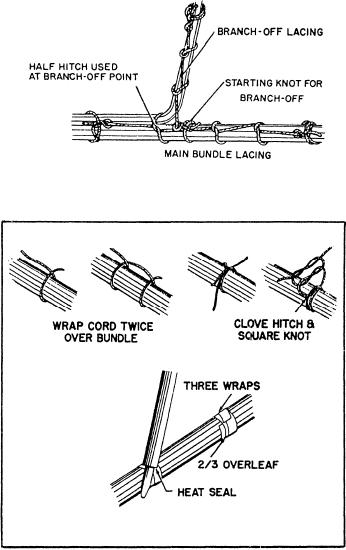
Make a tie as follows:
Branch-off Procedure.-- To lace a wire group that
branches off the main wire bundle (fig. 5-15), use the
1. Wrap cord around the wire group or bundle.
following steps:
2. Make a clove hitch, followed by a square knot
1. Start the branch-off lacing with a starting knot
with an extra loop.
located on the main bundle just past the branch-off point.
3 . Trim the free ends of cord to a 3/8-inch
When using single-cord lacing, make the starting knot
minimum.
the same as for regular single-cord lacing. When using
double-cord lacing, use the double-cord lacing starting
Tying Sleeves. When tying sleeves to wire groups
knot.
or bundles, make the ties the same way as you would for
wire groups or bundles.
2. End the lacing with the regular knot used in
single- and double-cord lacing as described earlier.
When it is permitted to use tape, use the following
method:
3. Trim the free ends of the lacing cord to a 3/8-inch
minimum.
1. Wrap the tape around the wire group or bundle
three times with a two-thirds overlap for each turn.
TYING TECHNIQUES. You will use specific
tying techniques for different conditions. Some of these
2. Heat-seal the loose tape end with the side of a
techniques are described in the following sections.
Spacing Ties.-- On the all-wire groups or bundles
Do not use tape for securing wire groups or bundles
that may require frequent maintenance.
where supports are more than 12 inches apart, space ties
12 inches or less apart (fig. 5-16).
Using Cable Straps. Cable straps are adjustable,
self-clinching, lightweight, flat, nylon straps with
molded ribs or serrations on the inside surface to grip
the wire. Use cable straps instead of individual cord ties
for fast securing wire groups or bundles. Cable straps
are available in various sizes and colors to clamp and
identify different sizes of wire groups or bundles.
WIRE WRAPPING
During maintenance and troubleshooting of
engineering control and surveillance system (ECSS)
Figure 5-15.--Lacing a branch-off.
consoles, take notice of the method used to attach the
wires to the backplanes of the consoles. The procedure
used is called wire wrapping. In this section, we will
discuss the principles and techniques involved in this
important procedure.
In simple terms, wire wrapping is the process of
using a series of turns to wrap a single solid wire around
a pin. The equipment on which you would use wire
wrapping have long, square pins or posts at the rear of
the female connectors. The back plane of a console is a
good example of this configuration. The pins are long
enough to allow one to three wires to be wrapped around
them in separate wraps. (A wrap is a single solid wire
wrapped around a pin in a series of turns.) The female
connectors are then connected from pin to pin by a small,
solid-insulated wire, which may or may not be color
coded.
NOTE: Machine-wrapped assemblies usually do
Figure 5-16.--Tying groups of bundles.
not have color-coded wiring. Hand-wrapped assemblies
5-14.

